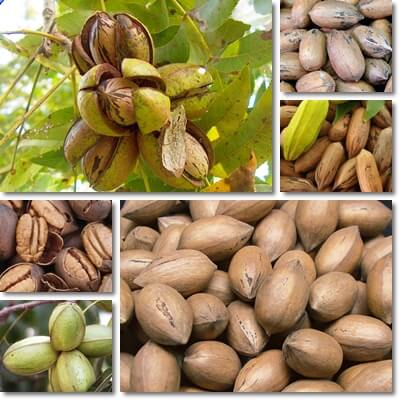The glycemic index, or GI, essentially predicts foods effects on blood sugar. It is a numerical scale that goes from 0 to 100, 100 being the highest value assigned to glucose. Glucose is a simple sugar and the main circulating sugar in the bloodstream. It is generally obtained from digestible carbohydrates from food. All foods that are sources of digestible carbohydrates get broken down into sugar which is then absorbed into the bloodstream, raising levels there.
The glycemic index basically assigns a numerical score to foods based on how fast they raise blood sugar levels. Between 0-55 is a low GI. Between 56-69 is a moderate GI. Between 70-100 is a high GI. Low GI foods either have few carbohydrates overall (per serving) or a lot of the carbohydrates they contain are complex or indigestible (such as dietary fiber). This results in a slow and steady rise in blood sugar levels which benefits diabetes type 2 and 1 patients the most.

What is the glycemic index of pecans?
Pecans glycemic index has not been determined yet, but is presumed to be around 20, same as the glycemic index of most other nuts and seeds. This is quite a low score, but in line with the values determined for similar foods. Almonds, peanuts, pistachios, walnuts, Brazil and Macadamia nuts, hazelnuts all have GI scores of around 15-25. Given that pecans have a nutritional profile that is surprisingly similar to that of other nut and seed varieties, it is reasonable to assume their glycemic effects correspond as well, making them low-glycemic too. The article will be updated once more information on the GI of pecans becomes available.
How many carbs and how much sugar and fiber in pecans?
The type and amount of carbohydrates in a food largely determine its effects on blood sugar. A good food for diabetics should have a modest carbohydrate content and be low in simple sugars but high in fiber. In 100 g of pecans there are 13.86 g of total carbohydrates of which 3.97 g simple sugars and 9.6 g dietary fiber. A 1-oz or 1-ounce serving (or the equivalent of 28.35 g or 19 pecan halves) provides 3.93 g of carbohydrates of which 1.13 g are simple sugars and 2.7 g dietary fiber.
Overall, there are not many carbs in pecan nuts (only 13.86 g per 100 g and 3.93 per ounce). Most important, over half of the total carb content is made of dietary fiber. Dietary fiber is indigestible plant material that does not contribute to blood sugar levels. Instead, it delays stomach emptying and slows down the rate of sugar absorption into the bloodstream, contributing to better control. Foods that are high in dietary fiber make excellent choices for diabetics looking to improve their health.

How much fat and protein in pecans?
Another reason why pecans are low-glycemic is their high fat and good protein content. 100 g of the nuts provides 71.97 g of fat and 9.17 g of protein, whereas a 1-ounce serving has 20.4 g of fat and 2.6 g of protein. Both of these nutrients have a longer digestion time compared to carbohydrates which results in a steadier, more controlled rise in blood sugar levels. But while the high-fat content holds benefits for blood sugar control, foods as high in fat as pecans are best eaten infrequently (or at least not every single day) to avoid weight gain. Excess weight is a source of complications for diabetics.
What is the glycemic load of pecans?
The glycemic load, or GL, is a scale that measures how fast a serving of a food raises blood sugar levels. Below 10 is a low GL. Between 11-19 is a moderate GL. Over 20 is a high GL. The GL of a food is determined based on the GI score multiplied by the number of carbohydrates in a serving of the food, divided by 100. Pecans are low-glycemic, despite their exact GI and GL score not having been determined yet. First of all, their modest carbohydrate, high fiber, high fat, good protein content supports their low-glycemic status. Secondly, their nutritional profile is fairly similar to that of other low-glycemic nuts and seeds. Also see 10 low-glycemic nuts and seeds.
How many pecans a day for diabetics?
For the most part, diabetics can have at least 1 one-ounce serving of pecan nuts a day. A 1-ounce serving equals 28.35 g of the nuts or 19 halves. However, given that one such serving gets you over 20 g of fat, it’s preferable to eat pecans infrequently (or at least not every single day) and limit intake to one serving a day, especially if you are struggling to reach a healthier weight or are not very physically active.
Know that a single one-ounce serving has almost 200 kcal, a significant energetic value for such a small amount of food. Fortunately, pecans are also satiating and filling, for the most part thanks to their generous fiber and fat content, so they both help curb hunger and provide lasting energy. Nonetheless, they are best consumed in reasonably small amounts. Ideally, food intakes should be determined according to the diabetic person’s individual nutritional requirements, based on current state of health and weight as well as level of physical activity.
Some of the benefits associated with eating pecans with diabetes include: better blood sugar and insulin control, improved glucose tolerance as well as benefits for diabetes-associated high blood pressure thanks to a good potassium and magnesium content, potential benefits for blood cholesterol and diabetes-associated nerve damage from a varied B vitamin content and for wound healing from good amounts of zinc and vitamin E. Pecans are also satiating and provide iron with a revitalizing effect as well as lots of B vitamins for energy metabolism, supporting an active lifestyle and overall good health. Provided, of course, they are consumed in reasonable amounts.
